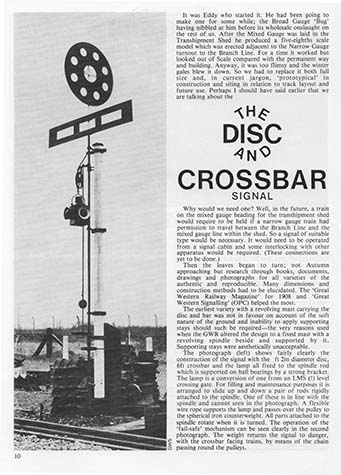Great Western Echo — No.85. Spring 1984 pp.10-11
‘The Disc and Crossbar Signal’ by David Hartland
© Great Western Society

It was Eddy who started it. He had been going to make one for some while; the Broad Gauge 'Bug' having nibbled at him before its wholesale onslaught on the rest of us. After the Mixed Gauge was laid in the Transhipment Shed he produced a five-eighths scale model which was erected adjacent to the Narrow Gauge turnout to the Branch Line. For a time it worked but looked out of scale compared with the permanent way and building. Anyway, it was too flimsy and the winter gales blew it down. So we had to replace it both full size and, in current jargon, 'prototypical' in construction and siting in relation to track layout and future use. Perhaps I should have said earlier that we are talking about the Disc and Crossbar Signal.
Why would we need one? Well, in the future, a train on the mixed gauge heading for the transhipment shed would require to be held if a narrow gauge train had permission to travel between the Branch Line and the mixed gauge line within the shed. So a signal of suitable type would be necessary. It would need to be operated from a signal cabin and some interlocking with other apparatus would be required. (These connections are yet to be done.) Then the leaves began to turn; not autumn approaching but research through books, documents, drawings and photographs for all varieties of the authentic and reproducible. Many dimensions and construction methods had to be elucidated. The 'Great Western Railway Magazine' for 1908 and 'Great Western Signalling' (OPC) helped the most. The earliest variety with a revolving mast carrying the disc and bar was not in favour on account of the soft nature of the ground and inability to apply supporting stays should such be required - the very reasons used when the GWR altered the design to a fixed mast with a revolving spindle beside and supported by it. Supporting stays were aesthetically unacceptable.
The photograph shows fairly clearly the construction of the signal with the ft 2in [sic] diameter disc, 6ft crossbar and the lamp all fixed to the spindle rod which is supported on ball bearings by a strong bracket The lamp is a conversion of one from an LMS (!) level crossing gate. For filling and maintenance purposes it is arranged to slide up and down a pair of rods rigidly attached to the spindle. One of these is in line with the spindle and cannot be seen in the photograph. A flexible wire rope supports the lamp and passes over the pulley to the spherical iron counterweight. All parts attached to the spindle rotate when it is turned. The operation of the 'fail-safe' mechanism can be seen clearly in the second photograph. The weight returns the signal to danger, with the crossbar facing trains, by means of the chain passing round the pulleys.
Like all Brunel's railway construction this signal is simple, solid and sound. Its siting is constrained by the need to eliminate any possible confusion with signalling on the narrow gauge Branch Line otherwise it would have been erected on the left side of the line to which it refers. Its erection, it was discovered, had to be carried out in a completed state. This meant digging in the same way as the builders of Stonehenge i.e. a hole deep enough and with a gently sloping side. Then eight stalwarts lowered the base post down the slope and supported the disc and crossbar to avoid bending the rod. The lift to the vertical beat us and it was only with the assistance of some Bristol Group signallers and particularly the crew commandeered from a passing train on the Branch Line that we were able to lift and turn the signal to the proper attitude. The hole was filled in and the fill compacted. Then a ladder was placed against the rod for the writer to apply the finishing red gloss on the approach faces and white on the rear of the disc and crossbar. The post was painted white and the rest of the signal black. Finally the lamp was positioned on its slidebars thus completing a fitting accessory to the Broad Gauge scene at Didcot.
To return to the History Page - Simply close this window